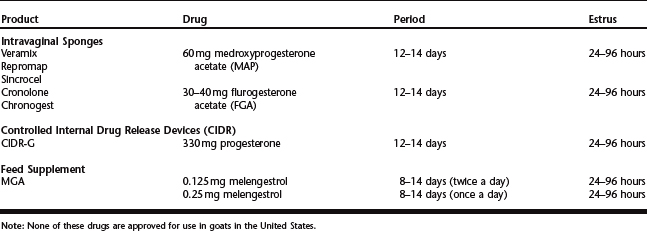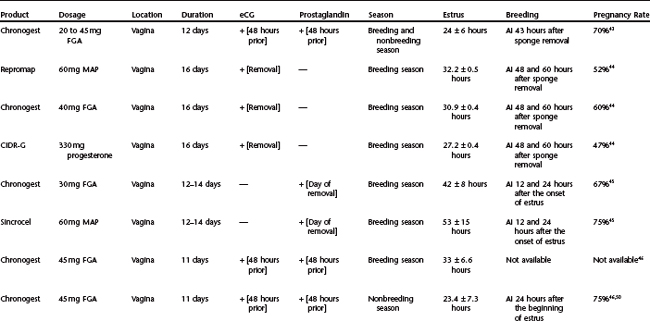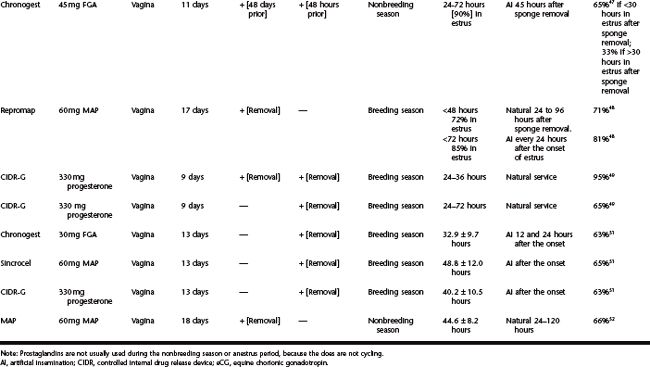CHAPTER 71 Manipulating the Estrous Cycle in a Doe
Goats are generally classified as “seasonally polyestrous” or short-day breeders in a temperate region. The degree of seasonality varies among breeds and their locations (latitude). Thus, the length of the breeding season is most influenced by photoperiod, breed, and nutritional status of the doe.
Native breeds near the equator generally cycle throughout the year.1–3 In a temperate climate, goats are usually short-day breeders and have regular estrous cycles or heat cycles between August and March. But in the Northern Hemisphere in a temperate zone, the breeding season is much shorter, usually from October to December.1,3,4
Photoperiod and its influence on the secretion of melatonin from the pineal gland during the hours of darkness are important signals for cyclicity in the fall. The underlying influence of photoperiod, and its effects on cyclicity, is mediated through changes in pulsatile release of gonadotropin-releasing hormone (GnRH) from the hypothalamus, and the release of luteinizing hormone (LH) from the anterior pituitary gland.5–19
Estrus synchronization in animals that cycle throughout the year (polyestrous) focuses on manipulating either the luteal or follicular phase of their cycle. In does (seasonally polyestrous) during the breeding season, the opportunity to control their cycle is greater during the luteal phase, which is of longer duration and is more responsive to manipulation.22 Strategies can be employed to extend the luteal phase by supplying exogenous progesterone or to shorten this phase by prematurely regressing existing corporal lutea (CL).20–27 Different protocols have been established for effective synchrony of the estrous cycle, and also to provide an acceptable level of fertility, when utilizing artificial insemination or natural mating. Hormones have been used in goats to manipulate the estrous cycle, but none have been approved for use on goats in the United States.
The transition period is between the nonbreeding and breeding season. Does are not spontaneously cycling but can be induced to initiate estrous cycles with buck exposure or hormonal therapy. It is usually between July and August, and it depends upon the location, breed, and nutritional status of the doe. At the end of the breeding season a transitional period is believed to occur before the nonbreeding or anestrus period (March and April), when the does’ breeding activity declines.1,20,21
During the breeding season, estrus synchronization is best done utilizing hormones either by extending the luteal phase by supplying exogenous progesterone (Table 71-1), or by shortening the diestrus phase by prematurely regressing the existing corpus luteum (Table 71-2).20–27 Extending the luteal phase by supplying exogenous progesterone is best done by utilizing intravaginal sponges, controlled internal drug release devices (CIDR), and feed supplements.21,22,25,26 For better synchrony of estrus and ovulation, gonadotropins and prostaglandins are used at or near the end of the progestin treatment (Tables 71-3 and 71-4). Gonadotropins commonly used are follicle-stimulating hormone (FSH) and equine chorionic gonadotropin (eCG). Equine chorionic gonadotropin is commonly used because of its longer half-life than FSH. The drawbacks of using eCG are as follows: higher doses many result in large numbers of anovulated follicles, and repeated usage can cause declining fertility due to the presence of antibodies against eCG.20,21,28,33 eCG is not commercially available in the United States, but a product containing both eCG and human gonadotropin, which is labeled for use in gilts (PG600), has been tried and used successfully in goats.
Table 71-1 Extending the Luteal Phase: Progesterone or Progestagen Products Used to Synchronize Estrus in Goats20–24,26,27,39,54

Table 71-3 Gonadotropin Products23,26
| Product | Dosage | Route |
|---|---|---|
| PG 600 5 ml contains 400 IUeCG, 200 IUhCG | Full dose, 5 ml (off season, transition, and breeding seasons) | Intramuscular |
| Equinex, Stimukron, Fostim, Folligon (equine chorionic gonadotropin, eCG) | 400-500 IU off season and transition period 200-300 IU, breeding season | Intramuscular |
Note: None of these agents has been approved for use in goats in the United States. Equine chorionic gonadotropin (eCG) mainly has FSH-like activity. Human chorionic gonadotropin (hCG) has LH-like activity.
Data in this table have been derived from Keisler DH: Endocrine control of reproduction in the ewe and ram. Proceedings of Small Ruminant Short Course (ACT and SFT), Kansas City, Mo, August 1994, pp 2-31 and Keisler DH, Buckrell BC: Breeding strategies in ewes. In Youngquist RS (ed): Current therapy in large animal theriogenology. St. Louis: Elsevier, 1997, pp 603-611.
TRANSITIONAL PERIOD
The buck effect is a powerful tool to enhance induction of estrus in does. Sudden introduction of previously isolated bucks to does will stimulate a surge of LH followed by ovulation in majority of does (97%) within 48 to 72 hours.29,30,31 The initial ovulation in these animals is accompanied by estrus in 60% of the does.29 From 30% to 60% (75%29) of the does will short cycle and ovulate again in 3 to 8 days or 7 to 12 days after the introduction of the buck.20,21,27,29–31,34 Two peaks of conception have been observed after the introduction of bucks; the first one is at 7 to 12 days and the second one is about 28 to 35 days.2,21,29 In Creole goats, which are less seasonal breeders, three peaks of conception have been observed. The first peak occurred at 3 to 5 days, the second at 8 to11 days, and the third at 27 to 29 days after the introduction of the buck.29 This phenomenon of short cycling in late transition in does may be due to lack of prior exposure of the reproductive tract to progesterone, and the corpora lutea that form initially are short lived due to early luteal regression (ELR).21,27,29–34 In sheep the current thinking is that early luteal regression may be due to lack of progesterone priming and the positive effects of estradiol on the uterus. Estrogen increases the availability of oxytocin receptors, leading to the release of PGF2 alpha from these receptors, and thus lysing the corpus luteum.32,33,34
Does that were supplemented with progesterone (45 mg of FGA [flurogesterone acetate]) in late transition, with the sponges removed on the day the bucks were introduced, had a higher percentage of does showing estrus and reducing the number of short cycles (ELR).31 Buck effect and exogenous hormones are methods commonly employed to induce estrus in the transitional period (Table 71-5).
Table 71-5 Different Methods Employed to Hasten Cyclicity During the Transition Period
| Method | Duration | Estrous |
|---|---|---|
Stay updated, free articles. Join our Telegram channel
Full access? Get Clinical Tree
 Get Clinical Tree app for offline access
Get Clinical Tree app for offline access

|


